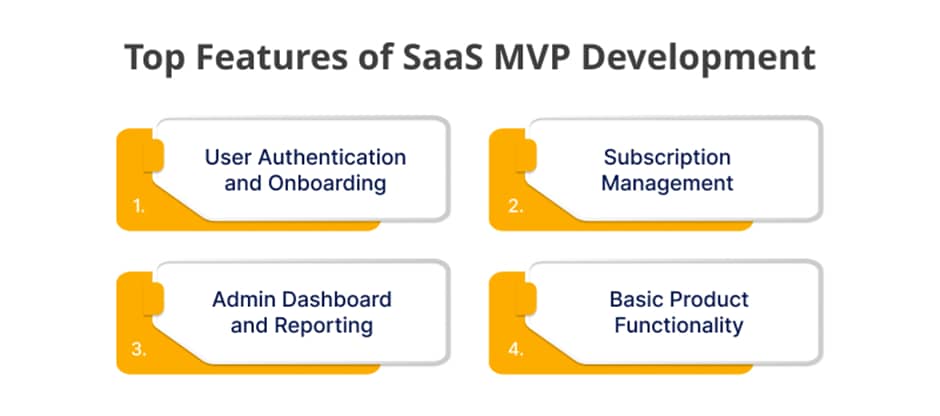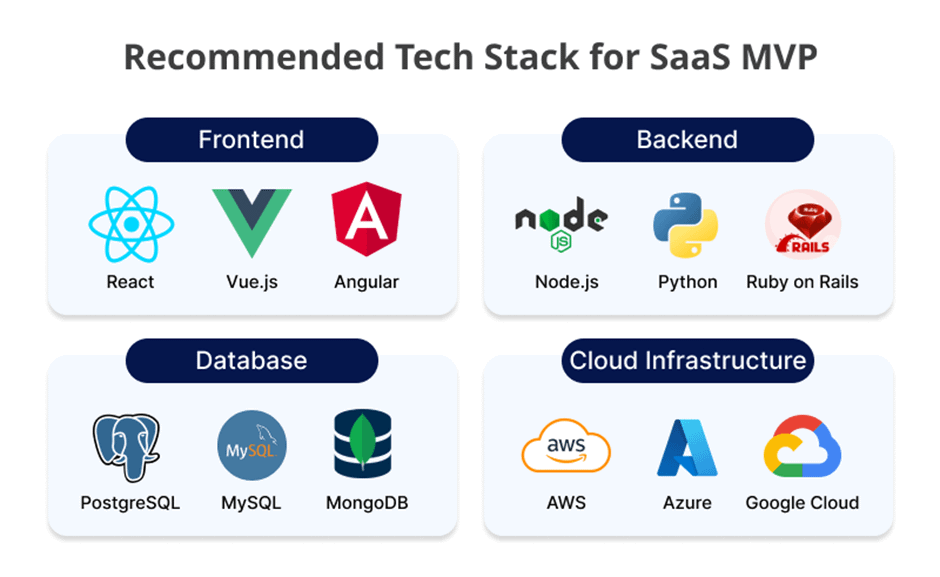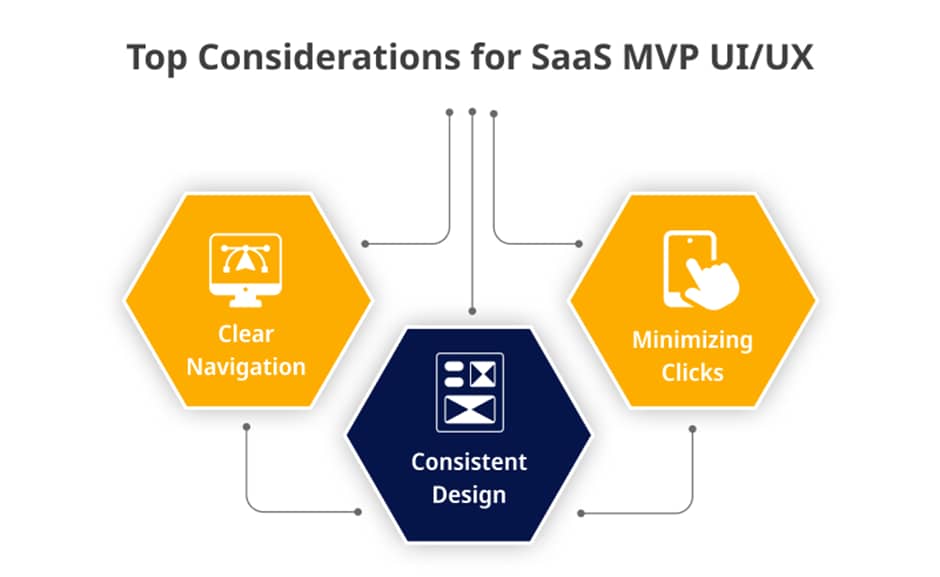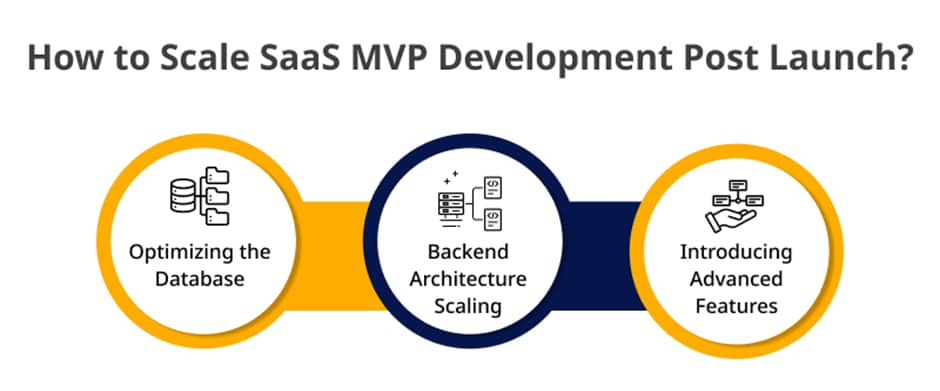Building a Minimum Viable Product (MVP) is crucial for swiftly bringing your product to market while minimising risks.
An MVP allows businesses to validate their core idea by focusing on essential features, gathering real-time feedback, and making data-driven improvements. This lean approach ensures resources are used efficiently and offers quick iterations based on user feedback.
However, successful SaaS MVP development requires a delicate balance between technical decisions and user-focused features, which ensures scalability without sacrificing usability.
Check out this blog post for all the technical considerations for MVP development in SaaS.
Why choose an MVP approach for SaaS?
Choosing an MVP approach for SaaS platforms offers several advantages:

- Faster time to market: Focus on core features, launching sooner to capture early adopters.
- Reduced development costs: Lower upfront investment by avoiding unnecessary features.
- Real-time user feedback: Refine the product based on user input, improving usability and relevance.
- Risk mitigation: One key benefit of the SaaS development process is risk mitigation. It allows you to test the concept before full-scale development, ensuring that time and resources are invested only in validated features that meet customer needs.
Core features of a SaaS MVP development
When developing a Minimum Viable Product for SaaS, it is crucial to focus on core features that solve a specific user problem while minimising complexity. Here are the essential elements to include:

User authentication and onboarding: A seamless login and sign-up process ensures users can easily access the platform. Integrating secure authentication (like OAuth or email-based sign-ups) for an MVP helps build trust and simplifies user access.
Subscription management: Whether you offer a freemium model, trial period, or tiered pricing, subscription management is a core feature for any SaaS product. Incorporating a flexible system that allows users to upgrade, downgrade, or cancel their plans can drive conversions and retention.
Admin dashboard and reporting: Even at the MVP stage, an admin dashboard is key for monitoring user activity and performance and managing system operations. Basic reporting features that track key metrics like user growth, activity, and engagement are essential for gathering valuable data early on.
Basic product functionality: The core of the MVP should revolve around a single, impactful feature that addresses your target audience’s pain point. This approach aligns with MVP development best practices, ensuring a streamlined, focused product.
Choosing the right tech stack for a SaaS MVP
Selecting the right tech stack for your SaaS MVP is a critical decision that impacts the initial development and your product’s scalability, security, and flexibility. Here are the key factors to consider:
Scalability: Choose technologies that can grow with your business. As user demand increases, your tech stack should support scaling vertically (adding more resources) and horizontally (distributing the load across multiple servers).
Security: Even at the MVP stage, ensuring compliance with basic security standards is non-negotiable. Your tech stack should support data encryption, secure user authentication, and robust protection against common vulnerabilities.
Flexibility: It is essential to pivot or add new features as your SaaS product evolves. A flexible tech stack allows you to introduce updates or changes without major overhauls, ensuring a faster time to market for new features.
Choosing the right tech stack is more than just picking the latest tools. It is about aligning with your long-term vision and ensuring your SaaS MVP is built on a foundation that supports growth, security, and adaptability.
Recommended tech stacks

1. Frontend
React: Known for its speed and flexibility, React is ideal for building dynamic user interfaces.
Vue.js: Lightweight and easy to integrate, Vue.js is excellent for creating smooth user experiences.
Angular: Google’s framework, Angular, supports building complex and scalable web apps.
2. Backend
Node.js: Efficient and scalable, Node.js is a popular choice for real-time applications.
Python: With frameworks like Django and Flask, Python offers flexibility and rapid development capabilities.
Ruby on Rails: Known for its simplicity and convention-over-configuration philosophy, Rails allows for fast MVP development.
3. Database
PostgreSQL: A robust, open-source relational database with excellent scalability and compliance with ACID principles.
MySQL: A reliable relational database that’s widely used for SaaS applications.
MongoDB: A NoSQL database ideal for handling large volumes of unstructured data.
4. Cloud infrastructure
AWS: Offers a wide range of services and is highly scalable, making it a popular choice for MVPs.
Azure: Microsoft’s cloud platform is excellent for enterprise-level solutions with seamless integration.
Google Cloud: Known for its data analytics and AI capabilities, Google Cloud is a solid option for SaaS products.
Backend architecture for SaaS MVP development
When building a SaaS MVP, selecting the exemplary backend architecture is crucial for ensuring scalability, security, and maintainability. One of the first decisions to make is whether to use a multi-tenant or single-tenant architecture.
Multi-Tenant Architecture vs. Single-Tenant Architecture
Multi-tenant architecture: In a multi-tenant setup, multiple customers (tenants) share the same infrastructure and application instances, but their data remains isolated. This architecture is cost-effective and easier to manage at scale, making it an ideal choice for MVPs that need to scale rapidly.
Pros:
- Cost-effective, as resources are shared.
- Easier to manage updates and maintenance.
- Scales quickly as new tenants are added.
Cons:
- Shared resources could lead to performance issues for tenants with high traffic.
- Complex data security management, as each tenant’s data must remain isolated.
Single-tenant architecture: In a single-tenant model, each customer has their own dedicated infrastructure and software instance. This setup offers greater security and customisation but has higher costs and complexity.
Pros:
- Enhanced security, as each tenant’s environment is fully isolated.
- Greater flexibility for customisation.
Cons:
- Higher cost, as each tenant requires its resources.
- Scaling is more challenging, as each tenant must be managed individually.
For most SaaS MVPs, multi-tenant architecture is a more efficient choice, allowing faster scaling and resource optimisation.
Building a solid backend architecture ensures that your SaaS MVP is ready to handle growth, integrates seamlessly with third-party services, and provides a smooth user and administrator experience.
API-first approach:
With this approach, the API is developed as the central component of the application, enabling the backend to communicate seamlessly with multiple frontends, including web, mobile, and even third-party applications.
- Scalability: APIs can handle traffic spikes more efficiently and scale independently of the frontend.
- Maintainability: By decoupling the frontend and backend, updates and new features can be implemented with minimal user disruption.
- Flexibility: An API-first backend allows you to easily add more services and platforms as your SaaS product grows.
Integrating third-party services:
To use the benefits of MVP development, integrating third-party services like payment gateways, email systems, and analytics tools is essential:
- Payment gateways: Integrating services like Stripe or PayPal allows for secure and efficient payment processing, enabling you to offer subscription management from the start.
- Email services: Services like SendGrid or Mailgun help automate customer communications, including onboarding emails, notifications, and marketing campaigns.
- Analytics tools: Tools such as Google Analytics, Mixpanel, or Segment allow you to track user behavior, providing insights that inform product development and business strategies.
SaaS MVP UI/UX design considerations

Focusing on UI/UX design for MVP app development strategy ensures a seamless user experience. A simple, intuitive interface helps users navigate the platform effortlessly and ensures they can access core features quickly.
An MVP is designed to test the viability of a product with limited features, making a clean and intuitive UI/UX even more critical. A well-thought-out interface helps users understand the product quickly, eliminating unnecessary friction.
In the context of an MVP, it’s essential to avoid complexity. The interface should be streamlined to focus on core functionalities instead of overwhelming users with too many features or cluttered layouts. This includes:
- Clear navigation: Simple menus and well-labeled buttons.
- Consistent design: Uniformity in fonts, colors, and design elements across pages.
- Minimising clicks: Ensure users can accomplish tasks in as few steps as possible.
Minimal design does not mean stripping away important functionality but focusing on delivering only what is necessary. The MVP should still offer enough features to solve a core user problem while maintaining a clean and functional user experience.
The design should emphasise usability without unnecessary frills, offering a smooth experience that allows users to focus on the product’s value. Using design tools like Figma, Sketch, or Adobe XD can streamline the design process by allowing for efficient wireframing and prototyping.
Implementing security for SaaS MVP
The following steps help create a secure foundation for your SaaS product. To implement security for a SaaS MVP, you must focus on user data protection right from the start:
- SSL encryption ensures secure communication between the client and server.
- OAuth allows secure user authentication, safeguarding login processes.
- Data privacy measures must be enforced to comply with regulations and protect sensitive information.
- User roles and permissions should be clearly defined to manage access control and ensure different levels of authority across the platform.
Testing and iterating the MVP
Testing and iterating are essential for the success of SaaS MVP development. Through iterative testing, improvements can be made based on feedback, ensuring the product aligns with user needs and preferences. SaaS development services can assist with optimising this process.
- Testing: Ensure optimal functionality, usability, and performance through tools like Selenium for automated testing and Postman for API monitoring.
- Gathering Feedback: Implement strategies such as in-app surveys, user behavior analytics, and direct feedback loops post-launch.
- Iterating: Continuously improve the product based on insights gathered, allowing for quick fixes and feature enhancements that align with user needs and preferences.
Scaling the SaaS MVP development post-launch

After successfully launching your SaaS MVP and validating the core concept with users, the next phase is preparing for scaling.
The post-launch period turns the MVP into a fully-featured SaaS platform that can handle growth, meet user demands, and support long-term business goals. This involves:
Preparing for scaling the product
The database and backend architecture must be optimised for high performance to scale your SaaS product. During the MVP stage, simplicity often takes priority, but once the product gains traction, ensuring that the infrastructure can support increasing users is essential. Some key steps include:
Optimising the database
Implementing indexing strategies, query optimisation, and database partitioning to handle larger datasets efficiently.
Backend architecture scaling
Moving from monolithic architectures to microservices, enabling different platform components to scale independently and meet specific resource demands.
Introducing advanced features based on user demands
As your user base grows, so will their expectations for additional features and functionality. Post-launch, collecting user feedback and identifying the most requested or beneficial features is critical. These could include:
From MVP to a fully-featured SaaS platform
Moving from an MVP to a complete SaaS product involves thoughtful iteration and continuous improvements. This transition requires:
- Refining the user experience: Based on real-world usage and feedback, making necessary design and functionality improvements.
- Upgrading infrastructure: Ensuring the platform’s scalability, security, and reliability as more users onboard.
- Adopting DevOps practices: Implementing automated testing, CI/CD pipelines, and cloud infrastructure management to enable rapid feature releases and updates.
Key growth strategies for SaaS
To scale successfully, your growth strategy should combine both technical and business improvements:
- Customer retention: Focus on onboarding, user support, and delivering a seamless experience to reduce churn.
- Pricing models: Introduce flexible subscription tiers (e.g., freemium, premium) to accommodate different user segments.
- Marketing and outreach: To expand your user base, leverage data-driven marketing strategies, such as targeted ads, content marketing, and referral programs.
By preparing the technical infrastructure for scalability and continuously improving the product based on user needs, you can effectively transition from a basic MVP to a robust, full-scale SaaS platform that drives long-term success.
Conclusion
Building an MVP for a SaaS platform involves making smart technical choices that lay the groundwork for future growth.
By focusing on essential features, choosing the right tech stack, and iterating based on user feedback, you can minimise risk and ensure your product aligns with market needs.
Focusing on a Minimum Viable Product for SaaS and iterating based on feedback will help your product evolve into a full-scale solution that meets market demands. If you’re ready to take your idea to the next level, consider MVP development services to guide you.






Leave a Comment